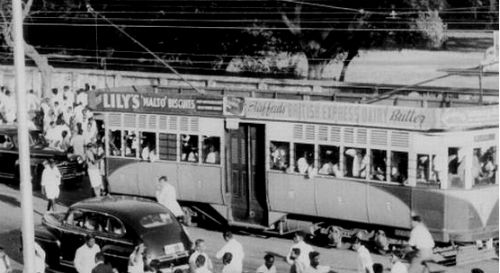Registered with the Registrar of Newspapers for India under R.N.I 53640/91
Vol. XXVII No. 21, February 16-28, 2018
Metro’s ancestor Remembered
N.S. Parthasarathy
Commuters’ nostalgia…

The Chennai Metro takes my memory back to the early mass transit system in Madras that is Chennai. From tramway to metro, for mass transit, Chennai has come a long way. Madras Tramways, which ceased to operate in 1953, had a character of its own in many ways. The main line ran from Parry’s Corner to Luz junction, passing through the Central station area. The east-west line shuttled between Central and Roxy at Purasawalkam. Connecting shuttles also operated on the Parry’ Corner-Royapuram and Luz-San Thomé sections.
A ride from Sripuram off Royapettah High Road to Parry’s took nearly an hour and cost 2 annas, i.e., the equivalent of today’s 16 paise. On Sundays you could buy a go-as-you-please ticket for 4 annas which is a quarter of today’s Rupee.
Polished wooden seats with back-rests were arranged in two long rows on either side facing each other. In rush hours, it could take in standing passengers in the central space between the two bench rows. In peak hours, passengers overflowed into the driver’s spaces in the front and back and sometimes even to the footboard.
Even at a speed of ten miles an hour, the long vehicle swayed gently from side to side. The more athletic of passengers found it convenient to hop on or hop off the tram at spots of their convenience, ignoring pictorial warnings of the risks of such practices. The metallic “clanging” sound of the oncoming tram was enough to alert office-goers to time their leaving home to board the tram. If you had an ear for the subtleties of different “notes” in the “clanging”, it was a game to guess which particular tram was approaching! The trams could be distinguished by the long-bannered advertisements they carried at the top on either side. The approaching tram could be one that commended Ovaltine for Good Health or Zandu’s Oriental Balm for All Your Pains or Woodward’s Gripe Water for Babies or Lodhra Ladies’ Tonic. Guessing them right, my younger brother, who had this cognitive skill, beat me to it most of the time in this game. Incidentally, only Woodward’s of these once-celebrated brand seems to have survived the ravages of time.
The tramway offered much collateral social value besides mere transport. The leisurely travel afforded many an opportunity for fellowship and to talk of cabbages and kings; some groups formed lasting friendships kept reinforced by the synchronised travel every morning or evening to or from work. The social bug also bit the driver. He struck up friendships with regulars among passengers so much so that he knew the drop-off or pick-up points of his favourite customers. The tram would slow down suggestively at places that had no scheduled stops to take on or drop off his friends.
In New Zealand, recently, I saw an interesting public relations sign in the buses that said: This Bus Kneels for You. It did, when the driver pressed a button, seeing me trying to get down with some difficulty, to extend a concealed foot board close to the ground level. The driver slowing down the tram for regulars carried a similar personal touch. Students had a fine time hop-skip-jumping on to the footboard and hopping off without paying the fare. Quite a few had free rides before the conductor reached them to issue their tickets. No wonder Madras Tramways had to eventually close down because of mounting losses.
We lived near the tram shed at the junction of today’s Thiru Vi Ka Road and Radhakrishnan Salai. The return of trams to the shed after ten at night was a noisy affair as the shed supervisors had to shout instructions to drivers directing incoming trams to different parking tracks. The service started at sunrise and the early noise and bustle in the shed was our morning wake up call. It was also time to watch our milkman at the gate for the pre-sunrise milking in our presence the timing was deliberate perhaps! A swish of the milk can was followed by the main act of milking. The swish was meant to show that there was no water in it to enlarge the volume of the genuine stuff from the kindly animal. Only many years later, after I watched similar tricks performed by barmen in Bangalore pubs with filled beer mugs, did I understand why the milk was watery despite the swish.
The sounds and smells of the tramway became a part of the ambience and were not intrusive such that we missed them very much when the service stopped in 1953. In San Francisco when the iconic cable car was withdrawn, a citizens’ committee initiated a movement for its restoration. There was no such movement for Madras Tramways’ restoration. It stopped one fine morning, unsung, unhonoured and unnoticed.

